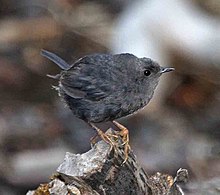Magellanic tapaculo
| Magellanic tapaculo | |
|---|---|

| |
| at Cerro Chapelco, San Martín de los Andes, Neuquén Province, Argentina | |
| Scientific classification | |
| Domain: | Eukaryota |
| Kingdom: | Animalia |
| Phylum: | Chordata |
| Class: | Aves |
| Order: | Passeriformes |
| Family: | Rhinocryptidae |
| Genus: | Scytalopus |
| Species: | S. magellanicus
|
| Binomial name | |
| Scytalopus magellanicus (Gmelin, JF, 1789)
| |

| |
The Magellanic tapaculo (Scytalopus magellanicus) is a small
Rhinocryptidae that is found in southern South America
.
Taxonomy

The Magellanic tapaculo was
monotypic: no subspecies are recognised.[6]
The species was often known as the Andean tapaculo in the past and included a number of subspecies distributed along the Andes. These are now treated as species in their own right, leaving the Magellanic tapaculo with no subspecies although birds in the north of its range are larger and darker and may deserve subspecies status.
Description
It is a
song is loud, staccato and repetitive.[7]
Distribution and habitat
Its range extends northwards from
San Juan Province in Argentina. Charles Darwin collected a specimen in the Falkland Islands in 1833 or 1834 but there have been no definite records there since. It inhabits dense vegetation near ground-level in forest and woodland where it forages for insects. It often occurs near water and is commonly associated with stands of Chusquea bamboo
.
Behaviour
It is terrestrial and prefers to run rather than fly.
Breeding
The domed
eggs are laid.[7]
References
- . Retrieved 11 November 2021.
- ^ Gmelin, Johann Friedrich (1789). Systema naturae per regna tria naturae : secundum classes, ordines, genera, species, cum characteribus, differentiis, synonymis, locis (in Latin). Vol. 1, Part 2 (13th ed.). Lipsiae [Leipzig]: Georg. Emanuel. Beer. p. 979.
- ^ Peters, James Lee, ed. (1951). Check-List of Birds of the World. Vol. 7. Cambridge, Massachusetts: Museum of Comparative Zoology. p. 288.
- ^ Latham, John (1783). A General Synopsis of Birds. Vol. 2, Part 2. London: Printed for Leigh and Sotheby. p. 464, No. 72.
- doi:10.5962/p.92313.
- Rasmussen, Pamela, eds. (January 2023). "Antthrushes, antpittas, gnateaters, tapaculos, crescentchests". IOC World Bird List Version 13.1. International Ornithologists' Union. Retrieved 16 March 2023.
- ^ ISBN 978-84-87334-50-4.
External links
 Data related to Scytalopus magellanicus at Wikispecies
Data related to Scytalopus magellanicus at Wikispecies- Aves de Chile
- Magellanic tapaculo videos at IBC.

